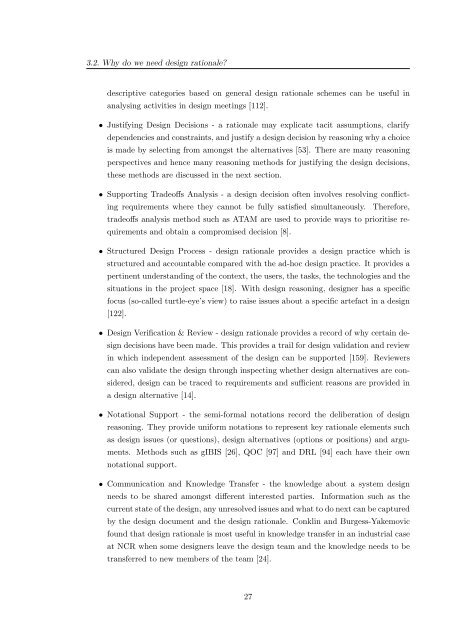A Rationale-based Model for Architecture Design Reasoning
A Rationale-based Model for Architecture Design Reasoning
A Rationale-based Model for Architecture Design Reasoning
Create successful ePaper yourself
Turn your PDF publications into a flip-book with our unique Google optimized e-Paper software.
3.2. Why do we need design rationale?<br />
descriptive categories <strong>based</strong> on general design rationale schemes can be useful in<br />
analysing activities in design meetings [112].<br />
• Justifying <strong>Design</strong> Decisions - a rationale may explicate tacit assumptions, clarify<br />
dependencies and constraints, and justify a design decision by reasoning why a choice<br />
is made by selecting from amongst the alternatives [53]. There are many reasoning<br />
perspectives and hence many reasoning methods <strong>for</strong> justifying the design decisions,<br />
these methods are discussed in the next section.<br />
• Supporting Tradeoffs Analysis - a design decision often involves resolving conflicting<br />
requirements where they cannot be fully satisfied simultaneously. There<strong>for</strong>e,<br />
tradeoffs analysis method such as ATAM are used to provide ways to prioritise requirements<br />
and obtain a compromised decision [8].<br />
• Structured <strong>Design</strong> Process - design rationale provides a design practice which is<br />
structured and accountable compared with the ad-hoc design practice. It provides a<br />
pertinent understanding of the context, the users, the tasks, the technologies and the<br />
situations in the project space [18]. With design reasoning, designer has a specific<br />
focus (so-called turtle-eye’s view) to raise issues about a specific artefact in a design<br />
[122].<br />
• <strong>Design</strong> Verification & Review - design rationale provides a record of why certain design<br />
decisions have been made. This provides a trail <strong>for</strong> design validation and review<br />
in which independent assessment of the design can be supported [159]. Reviewers<br />
can also validate the design through inspecting whether design alternatives are considered,<br />
design can be traced to requirements and sufficient reasons are provided in<br />
a design alternative [14].<br />
• Notational Support - the semi-<strong>for</strong>mal notations record the deliberation of design<br />
reasoning. They provide uni<strong>for</strong>m notations to represent key rationale elements such<br />
as design issues (or questions), design alternatives (options or positions) and arguments.<br />
Methods such as gIBIS [26], QOC [97] and DRL [94] each have their own<br />
notational support.<br />
• Communication and Knowledge Transfer - the knowledge about a system design<br />
needs to be shared amongst different interested parties. In<strong>for</strong>mation such as the<br />
current state of the design, any unresolved issues and what to do next can be captured<br />
by the design document and the design rationale. Conklin and Burgess-Yakemovic<br />
found that design rationale is most useful in knowledge transfer in an industrial case<br />
at NCR when some designers leave the design team and the knowledge needs to be<br />
transferred to new members of the team [24].<br />
27

















